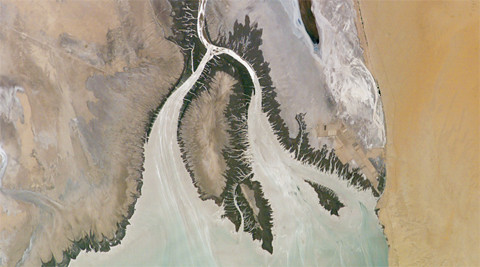I was interviewing a local flood control engineer recently about the lovely little wetland that’s grown up in a retention pond up near my work. It’s located just off one of the channels that carries flood flows down through the city, and its primary purpose is to catch and hold water for a while to reduce contaminant load that gets to the Rio Grande in flash flood events.
When I described it as a “wetland,” the engineer cautioned me about a linguistic subtlety. Its purpose, he explained, is not wildlife habitat, and to call it a “wetland” is to move it into a bureaucratic category for which it was not intended. So while it’s developed a lovely cattail marsh, with redwing blackbirds and grackels and all manner of travelling water fowl, it’s not a wildlife habitat site. Call that a happy accident.
That issue writ large is the situation at two much more famous western water sites I’ve been reading about lately: the Cienega de Santa Clara in the Colorado River Delta, and Owens Lake.

Courtesy NASA, the Colorado River Delta, with Cienega de Santa Clara in the upper right
The Cienega is at the end of the Welton-Mohawk drain, which was built to drain off brackish ag runoff from the Yuma area, to keep it from sullying the Colorado River. Where the drain ends in Mexico, a remarkable wetland has developed which has become one of the best wildlife habitats in the Lower Colorado.
Similarly, nature has apparently gone gangbusters in the Owens Valley as a result of a project that was nominally about adding enough water to keep down dust left after LA began siphoning away water a century ago for urban use, according to this KABC story:
The wind and dust made Owens Lake the largest single source of air pollution in the United States. However, that changed over the last ten years. Huge pipes, hundreds of smaller bubblers and thousands of tiny drippers, allow water to spread out across the vast expanse of Owens Lake. As a result, acres of green grass have sprouted on the lakebed and migratory birds have returned to the ponds. But all the water, roads and dikes are used for the sole purpose of keeping the dust down.
There are some really interesting water policy issues entangled here. In the Lower Colorado, a rich debate is underway about how to keep the Cienega alive given a plan to put the brackish water now flowing its way to other use. The Bureau of Reclamation has plans to restart the Yuma Desalting Plant and cleaning up said brackish water to put to what are considered, in U.S. water law, “beneficial uses”. That means drinking and growing food. In-stream flows and habitat are not considered “beneficial” under the law.
I’ll have more on the Cienega in coming months. I’m hoping to get down there for a writing project I’m working on, to visit both the Cienega itself and also the farms on both sides of the border that put water to what we more traditionally call “beneficial use.” In the meantime, I’m hoping to sneak off at lunch to the little pond by my office and check out the redwing blackbirds.



